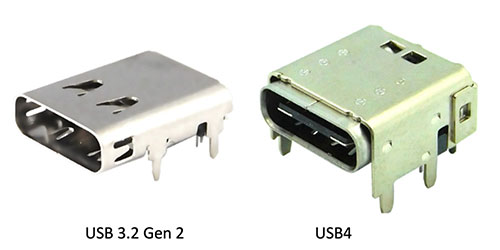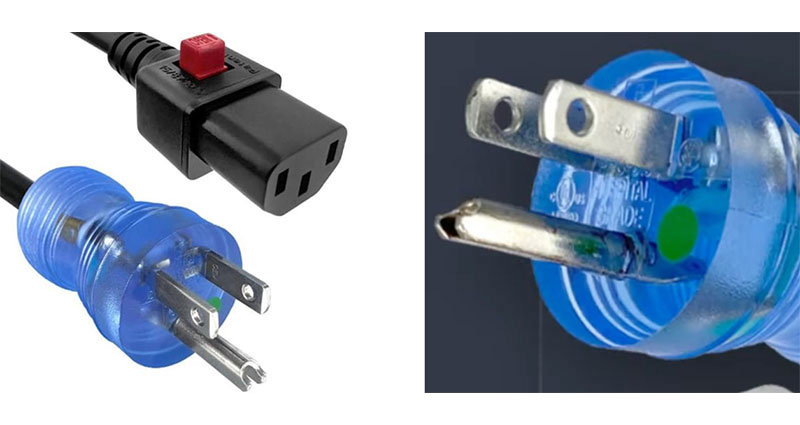What to Look for in Board-Mounted USB 3.2 Gen 2 and USB4 Receptacles
My first encounter with a USB Type-C connector (USB-C) was a wonderful experience. After years of attempting to insert a USB-A connector plug into the mating receptacle only to find that the plug was upside down, I found a USB connector that mated regardless of the plug orientation. That was only one of the wonders I now associate with USB-C connectors. This connector type can also share power and multiple data and display protocols at data rates of up to 40 gigabits per second (Gbps) while meeting signal integrity and electromagnetic interference (EMI) requirements.
When implementing USB-C connections on printed circuit boards (pc boards), designers are constantly pushed to save space while ensuring reliable connections. Stewart Connector’s USB-C receptacles are designed to meet these often conflicting requirements. Receptacles complying with either USB 3.2 Gen 2 (formerly USB 3.1) (left) or USB4 (right) specifications are shown in Figure 1.
 Figure 1: Shown are USB-C pc board receptacles for USB 3.2 Gen 2 (left) and USB4 (right). (Image source: Stewart Connector)
Figure 1: Shown are USB-C pc board receptacles for USB 3.2 Gen 2 (left) and USB4 (right). (Image source: Stewart Connector)
The right-angle receptacles are shielded and are backward compatible with earlier USB versions operating at lower speeds. The SS-52400-002 and SS-52400-003 are USB 3.2 Gen 2 compliant and suit board thicknesses of 0.039 inches (in.) (1 millimeter (mm)) and 0.063 in. (1.60 mm), respectively. The SS-52400-005 is USB4 compliant and suits boards 0.047 in. (1.20 mm) thick.
As mentioned previously, USB-C plugs and receptacles are reversible. The contacts are arranged for mating in both male and female orientations. The connectors provide power delivery, data transfer, and audio/video output per the USB Power Delivery (USB PD) standard in a single set. The USB-C receptacle signal assignments are shown in Figure 2.
 Figure 2: Shown are the USB-C receptacle signal assignments. (Image source: Stewart Connector)
Figure 2: Shown are the USB-C receptacle signal assignments. (Image source: Stewart Connector)
Many signals are available in a USB-C connector for data and power transfer as shown in Table 1.
 Table 1: USB-C connectors support power distribution, alternate data modes, and USB compatibility modes. (Table source: Art Pini)
Table 1: USB-C connectors support power distribution, alternate data modes, and USB compatibility modes. (Table source: Art Pini)
USB PD is an intelligent power delivery specification. It uses the Channel Configuration (CC) lines to negotiate the power contracts between the source and the sink (load). Voltage levels can be higher than 5 volts, and programmable power supplies are allowed.
The Stewart Connector SS-52400-002 and SS-52400-003 USB 3.2 Gen 2 receptacles support a maximum power level of 100 watts at 20 volts and 5 amperes (A). The SS-52400-005 USB4 receptacle is rated for 140 watts at 20 volts and 7 A. All the USB-C receptacles have an operating temperature range of -40 to 105°C.
After USB PD sets up the power contract between devices, it will initiate alternate mode data links like Display Port (DP) using Vendor Defined Messages (VDM). Subsequently, DP will proceed with link training to establish the relationship between a DP source and sink to ensure a robust connection for streaming data like video or audio. DP auxiliary (AUX) signals use the SBU (SBU1 and SBU2) signal pins. The AUX channel handles link management and test mode control. The SuperSpeed SSTx1, SSTx2, SSRx1, and SSRx2 lines form differential data paths to provide high-speed data links. The dedicated Dp and Dn lines maintain compatibility with older USB standards (USB 2 and lower).
USB PD is not just for power delivery; it also synchronizes the various protocols used in the alternate mode. The supported serial data protocols include Thunderbolt, DisplayPort, High-Definition Multimedia Interface (HDMI), and Mobile High-Definition Link (MHL). Additional interfaces can be easily added using VDM.
The slim design of Stewart Connector USB-C receptacles provides additional value by maximizing the use of the available pc board real estate. The receptacles have a hybrid pin design that uses through hole and surface mount pins to connect to the top and bottom layers of the pc board. On the manufacturing side, the USB-C receptacles are packaged in tape and reel for automated pick and place operations.
Conclusion
As exciting as it may be to have reversible connectors, it quickly becomes apparent that there is more to USB-C. It provides a standard connector for different audio, video, data storage, and communications protocols. It also provides for new and emerging standards as they are being developed. Stewart Connector’s solutions help meet designers’ needs by ensuring reliable and compact USB-C pc board connections.

Have questions or comments? Continue the conversation on TechForum, DigiKey's online community and technical resource.
Visit TechForum








